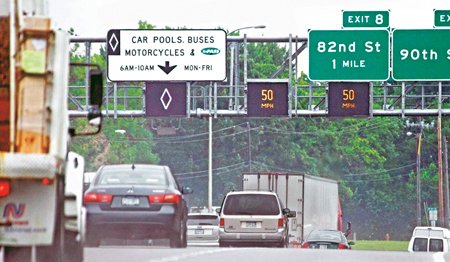Active Traffic Management
Active traffic management is the ability to dynamically and proactively manage recurrent and non-recurrent congestion on an entire facility based on prevailing traffic conditions. Focusing on trip reliability, these strategies maximise the effectiveness and efficiency of the facility while increasing throughput and safety. Active traffic management strategies rely on the use of integrated systems with new technology, including automated dynamic deployment to optimise system performance quickly and without the delay that occurs when operators must deploy operational strategies manually. When various active traffic management strategies are implemented in concert, they fully optimise the existing infrastructure and provide measurable benefits to the transportation network and the motoring public. These strategies include, but are not limited to, speed harmonisation, temporary shoulder use, junction control, queue warning, ramp metering, lane restrictions, and dynamic rerouting & traveller information. The following sections discuss a few of the more common strategies being used by agencies in the U.S. and overseas.
Variable Speed Limits
Variable speed limits help manage traffic by posting speed limits on a roadway or over each lane on an advisory or regulatory basis in real-time. Sometimes referred to as speed harmonisation, this approach has been in use in Germany since the 1970s and is oriented towards improving traffic flow based on prevailing conditions. Similar installations are in operation in The Netherlands and Great Britain on various roadway sections with high traffic volumes. A typical installation monitors traffic volumes, incidents and weather conditions along the roadway and modifies speed limits upstream if sudden disturbances occur in the traffic flow to provide drivers a warning of changing roadway conditions.
The most recent deployment of variable speed limits in the U.S. is in Seattle, Washington. The initial installation on I-5 as shown in Figure 2, involved a 7-mile stretch of the facility and included the installation of overhead sign bridges every half mile to warn of slower traffic and blocked lanes ahead to prevent collisions. Additional deployments are operational on I-90 and SR 520, and the Washington State Department of Transportation believes that drivers are following the speed limit and lane control signals, hoping to see a safety benefit over the long term.
Temporary Shoulder Use
In the United States, the primary use of shoulders has been seen as a safety refuge area. The limited shoulder use as a travel lane has been primarily reserved for special users of the roadway system, most often transit vehicles. Some shoulders use dates back to the 1970s, and many installations allowing all vehicles to use the shoulders have been in operation for more than 10 years to address congestion on urban corridors. Agencies have seen bus use of shoulders as a low-cost and quick strategy to improve bus operations and reliability without having to acquire additional right-of-way and invest additional large sums of money into the infrastructure. Overall, experience using shoulders for interim use has been positive in the United States, and more agencies are considering the strategy to address growing congestion on their urban freeway networks. In fact, several states have deployed temporary shoulder use for all vehicles on congested corridors with success.
A unique combination of strategies is operational on I-35W in Minneapolis where a segment has the left shoulder open during the peak periods. Known as priced dynamic shoulder lanes (PDSL), transit and carpools use the shoulder for free and MnPASS customers can use the shoulder for a fee. The left shoulder is open to traffic with overhead sign gantries indicating its operational status. When the general purpose lanes become congested, the shoulder is opened and the speed limit on the general purpose lanes is reduced. Opened in 2009, the section of I-35 between 42nd Street and downtown Minneapolis is open to buses, carpoolers, and MnPASS users during certain times when traffic is congested. The objective of the project is to improve traffic flow using transit and tolling. The shoulder treatment was also deployed with variable speed limits on the general purpose lanes.
Most urbanised areas around the world are facing serious mobility challenges, including an increase in travel demand, growth in congestion, a need to improve safety and the reality of limited resources to address these challenges. While not a substitute for large-capacity expansion projects, active management strategies like managed lanes and active traffic management are cost-effective methods of prolonging the life and maximising the efficiency of the infrastructure that can postpone the need for major expansion projects. They are also flexible enough to be implemented under temporary conditions in work zones and later be incorporated into the permanent operational infrastructure of a facility to extend the benefits to everyday operations.
Beverly T Kuhn
Ph.D., P.E.
Texas Transportation Institute
(Beverley Kuhn is Division Head and Senior Research Engineer with the System Reliability Division of the Texas Transportation Institute. She has been conducting research for over 20 years in freeway operations. She has specialised in active transportation, demand management and managed lanes. She serves as Chair of the System Users Section of Transportation Research Board and is also Vice-Chair, Coordinating Council of the Institute of Transportation Engineers.)
 TrafficInfraTech Magazine Linking People Places & Progress
TrafficInfraTech Magazine Linking People Places & Progress



